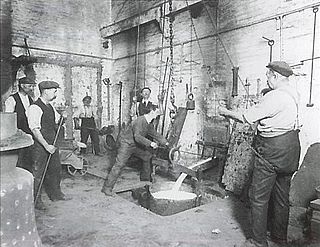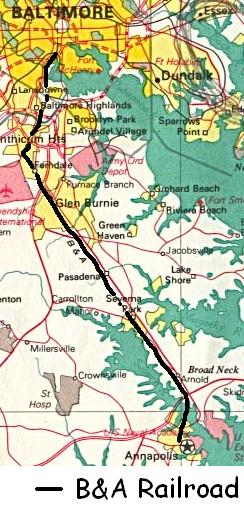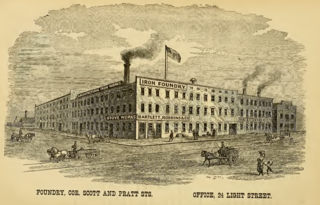
Glen Burnie is an unincorporated town and census-designated place (CDP) in Anne Arundel County, Maryland, United States. It is a suburb of Baltimore. The population was 72,891 at the 2020 census.

Dundalk is an unincorporated community and census-designated place in Baltimore County, Maryland, United States. The population was 67,796 at the 2020 census. In 1960 and 1970, Dundalk was the largest unincorporated community in Maryland. It was named after the town of Dundalk in County Louth, Ireland. Dundalk is considered one of the first inner-ring suburbs of Baltimore.

The Whitechapel Bell Foundry was a business in the London Borough of Tower Hamlets. At the time of the closure of its Whitechapel premises, it was the oldest manufacturing company in Great Britain.

American Type Founders (ATF) Co. was a business trust created in 1892 by the merger of 23 type foundries, representing about 85 percent of all type manufactured in the United States at the time. The new company, consisting of a consolidation of firms from throughout the United States, was incorporated in New Jersey.

John Taylor Bell Foundry (Loughborough) Limited, trading as John Taylor & Co and commonly known as Taylor's Bell Foundry, Taylor's of Loughborough, or simply Taylor's, is the world's largest working bell foundry. It is located in Loughborough, in the Charnwood borough of Leicestershire, England. The business originated in the 14th century, and the Taylor family took over in 1784.

Maryland Route 2 is the longest state highway in the U.S. state of Maryland. The 79.24-mile (127.52 km) route runs from Solomons Island in Calvert County north to an intersection with U.S. Route 1 /US 40 Truck in Baltimore. The route runs concurrent with MD 4 through much of Calvert County along a four-lane divided highway known as Solomons Island Road, passing through rural areas as well as the communities of Lusby, Port Republic, Prince Frederick, and Huntingtown. In Sunderland, MD 2 splits from MD 4 and continues north as two-lane undivided Solomons Island Road into Anne Arundel County, still passing through rural areas. Upon reaching Annapolis, the route runs concurrent with US 50/US 301 to the north of the city. Between Annapolis and Baltimore, MD 2 runs along the Governor Ritchie Highway, a multilane divided highway that heads through suburban areas, passing through Arnold, Severna Park, Pasadena, Glen Burnie, and Brooklyn Park. In Baltimore, the route heads north on city streets and passes through the downtown area of the city.

The J. G. Brill Company manufactured streetcars, interurban coaches, motor buses, trolleybuses and railroad cars in the United States for nearly 90 years, hence the longest-lasting trolley and interurban manufacturer. At its height, Brill was the largest manufacturer of streetcars and interurban cars in the US and produced more streetcars, interurbans and gas-electric cars than any other manufacturer, building more than 45,000 streetcars alone.

Gillett & Johnston was a clockmaker and bell foundry based in Croydon, England from 1844 until 1957. Between 1844 and 1950, over 14,000 tower clocks were made at the works. The company's most successful and prominent period of activity as a bellfounder was in the 1920s and 1930s, when it was responsible for supplying many important bells and carillons for sites across Britain and around the world.

A chime or set of chimes is a carillon-like instrument, i.e. a pitched percussion instrument consisting of 22 or fewer bells. Chimes are primarily played with a keyboard, but can also be played with an Ellacombe apparatus. Chimes are often automated, in the past with mechanical drums connected to clocks and in the present with electronic action. Bellfounders often did not attempt to tune chime bells to the same precision as carillon bells. Chimes are defined as specifically having fewer than 23 bells to distinguish them from the carillon. American chimes usually have one to one and a half diatonic octaves. According to a recent count, there are over 1,300 existing chimes throughout the world. Almost all are in the Netherlands and the United States, with most of the remainder in Western European countries.

Mars was a local chain of grocery stores in metropolitan Baltimore, Maryland. Mars operated 13 supermarket locations in the Baltimore area until it filed for bankruptcy in 2016.

The Cathedral of the Immaculate Conception in Saint John, New Brunswick, Canada is a cathedral of the Roman Catholic Diocese of Saint John located at 91 Waterloo Street in the city's central neighborhood of Waterloo Village.

The Baltimore & Annapolis Railroad (B&A) was an American railroad of central Maryland built in the 19th century to connect the cities of Baltimore and Annapolis. From 1897 to 1968 the railroad ran between Annapolis and Clifford along the north shore of the Severn River. From Clifford, just north of the present day Patapsco Light Rail Stop, it connected with the B&O's Curtis Bay branch so that trains could travel to Baltimore, though from 1914 to 1950 it bypassed this to travel instead to Carrol Junction and then to a terminal on Russell Street via the Camden Cutoff.

Glen Burnie High School is a large public high school located in the Baltimore suburb of Glen Burnie, Maryland, United States. Founded in 1923, the school is part of the Anne Arundel County Public Schools system.

Henry Northey Hooper was a 19th-century American manufacturer and merchant of decorative lighting, Civil War artillery, and bells and chimes. He was a Boston politician and foundry owner and in his firm he cast the first life-size bronze statue in the United States.

The Cathedral of Saint Andrew is the seat of the Roman Catholic Diocese of Little Rock in Little Rock, Arkansas, in the United States. It is located on South Louisiana Street in that city.

The Church of St. John the Evangelist is a parish of the Roman Catholic Church in the City of Orange Township, Essex County, New Jersey, within the Archdiocese of Newark. It is noted for its Gothic Revival style church (building), a prominent local landmark located at 94 Ridge Street.

J. C. Deagan, Inc. is a former musical instrument manufacturing company that developed and produced instruments from the late 19th- to mid-20th century. It was founded in 1880 by John Calhoun Deagan and initially manufactured glockenspiels. It was noted for its development of the xylophone, vibraharp, organ chimes, aluminum chimes, aluminum harp, Swiss handbells, the marimba, orchestra bells, and marimbaphone.

The Highland Arts Theatre Chime is a bell chime in the Highland Arts Theatre in Sydney, Cape Breton Regional Municipality, Nova Scotia, Canada. It consists of ten bells located in the south bell tower that are still in use today.

Bartlett-Hayward Company was an American metalworking company with large foundry, fabrication, and construction business lines, located in Baltimore, Maryland. Founded in the 1830s, it was independent until 1925 and since 1927 was owned by Koppers, of which it remained a division long afterward.



















